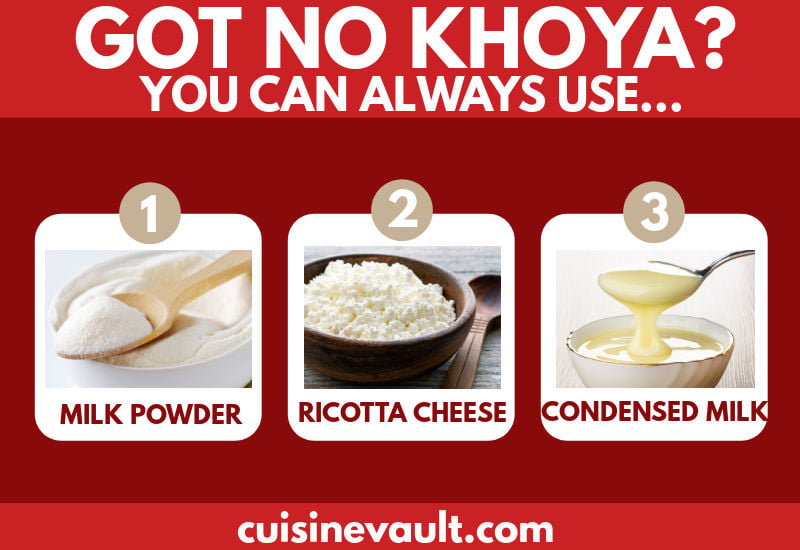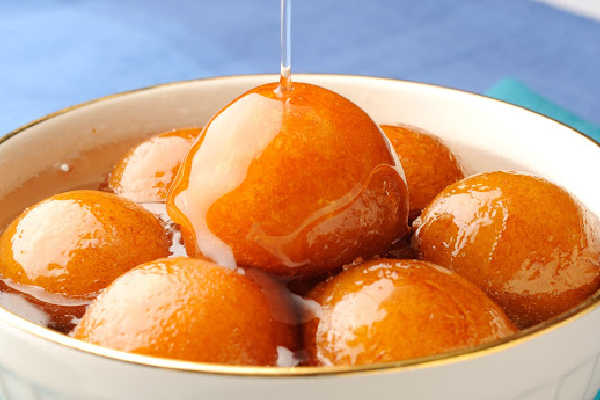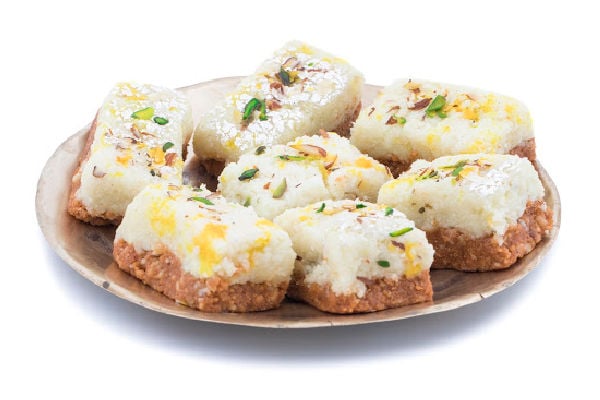Khoya is an ingredient that is used to make sweet dishes and curries in Indian cuisine. It is made by reducing milk until the moisture evaporates and a substance is left that is mild and slightly sweet in flavor. Depending on the variety, khoya’s texture can be soft, granular, or firm.
Although khoya is easy to find in India, Sri Lanka, and Pakistan, it is a scarce commodity in other parts of the world. If you can’t get your hands on any then you’ll need a replacement. We’ve pulled together our favorite khoya substitutes so that you can finish any recipe without the original ingredient.
What can I use as a khoya substitute?
The best alternatives for khoya are milk powder, ricotta cheese, or condensed milk. For a more authentic option, you can also make khoya at home; however, this will require extra time. Whatever substitute you choose from this list, keep in mind they will all require a small amount of preparation before adding to a recipe. Keep reading to find out how it’s done.
1. Milk powder
Making khoya at home can be time-consuming so a much faster option is to use full cream milk powder. Within 10 minutes you'll have enough to make delicious Indian Mithai (sweets) or a range of delicious desserts.
What you'll need
- 1 Tbsp ghee
- ¼ cup milk
- 2 cups full-fat milk powder
Method
- Add ghee and milk to a small pan and cook on medium heat until boiling then remove from heat.
- Scoop milk powder into a large bowl and pour hot ghee over the top. Mix gently until no lumps are remaining. A few extra teaspoons of milk may need to be added if the texture is too dry.
- Knead the mixture with your hands until it reaches a firm consistency then set aside and allow to cool completely. The khoya will harden a little but this is to be expected.
- The final dough can be grated or crumbled into dishes.
2. Ricotta cheese
Ricotta cheese is an excellent khoya alternative, but we recommend using the unsalted variety. It has a higher moisture level than khoya so it is essential to reduce the moisture by cooking.
Ricotta is a versatile replacement that will work well in ladoo, burfi, peda, and many other sweet treats. Next time Diwali arrives it won't matter if you have khoya or not.
3. Condensed milk
Condensed milk is probably the easiest backup option you can use for replacing khoya. Simply pour a can of the milk into a microwave-safe bowl along with two teaspoons of ghee. Microwave on high for four minutes before mixing and then testing the texture. If necessary, continue cooking for another two minutes and check again. Microwave ovens have different cooking times so keep a close eye on the bowl to make sure it doesn't burn.
Condensed milk is higher in sugar than khoya and increases the sweetness of anything you mix it with. If you're adding it to a dessert or candy recipe then we recommend reducing the sugar slightly.
 4. Make your own
4. Make your own
Making authentic khoya at home is time-consuming but thankfully it doesn't require your undivided attention. It is cooked on a very low heat and all that's required is an occasional stir.
You need a good quality non-stick pan with a thick bottom or a kadai so that the milk doesn't burn on the bottom. Choose a deep pan to avoid spill-overs.
Ingredients
- 5 cups full-fat milk
Method
- Add the milk to a heavy bottom nonstick pan and cook on a medium heat until it boils. Reduce the temperature to a low heat and continue to simmer, stirring every few minutes.
- Cook the milk for 50 minutes until its texture turns grainy. Once it reaches this consistency you will need to continuously stir the mixture to ensure it doesn't burn.
- Keep cooking until it reduces to a solid dough, similar to halwa. The total cooking time will take around 1¼ hours and towards the end, it takes quite a lot of effort to stir.
- Once you are happy with the texture, remove from the heat, and allow it to cool. During this time, it will continue to harden.
Tips for making khoya
- As the consistency of the dough turns sticky and hard, you can stop cooking early to create soft khoya.
- Try to use a large spatula to easily scrape the bottom of the pan.
- Khoya should be stored in an airtight container and can be refrigerated for up to four days or frozen for 2-3 months
- Always use fresh, full-fat milk for the best results.
- 5 pints of milk will produce around one pound of khoya although this will vary depending on the milk you use.
You might like to read:
A comparison of saag and palak paneer.
What are the best naan bread substitutes?
Basmati vs jasmine rice - what's the difference?
Types of khoya
Chikna Khoya (Soft)
Also known as chikna mawa or hariyali, this product has a sticky, squishy consistency with a 50% moisture content which is very high. It is made from low-fat milk and is excellent for making sweet food like halwa, rabri, and gulub jamuns. You may also love it in savory recipes such as royal gravy and shahi paneer.

Gulab jamuns made with soft khoya.
Danedar khoya (Granulated)
Commonly referred to as danedar mawa, this type of khoya has a thicker consistency than the chikna mawa mentioned above. Its texture is grainy as the milk is curdled with tartaric acid or alum during cooking. Dadenar is commonly used to make burfi and kalakand.

Freshly made mawa barfi.
Batti Ka Khoya (Hard)
Batti Ka Khoya means “rock” and is the hardest type of khoya as it only has 20% moisture. It is made from full-fat milk and can be aged for 12 months to develop a unique taste and aroma. In cooking, grate or crumble Batti Ka as you would cheese and add it to food like laddoos, burfies, or pedas.

Khoya peda made from hard khoya.
Related reading:
Japanese vs Indian curry - how do they compare?
How can I replace fenugreek in cooking?
Fast facts about khoya
- Khoya originated from the Indian subcontinent and is also known as khoa or mawa.
- In India, many people make sweets (mithai) at home during Diwali rather than buying them.
- Some popular uses for khoya include halwa, kala jamun, barfi, gulab jamun, gujiya, and pedha.
- Manufacturers in India produce around 600,000 metric tonnes of khoya each year.

Gujiya ready to be devoured.
Summing up
Khoya is a key ingredient in various Indian sweet treats but can be difficult to find in other parts of the world. If you can't find any at your local store then you can substitute it with milk powder, ricotta, or condensed milk. If you've got some spare time up your sleeve, easily make khoya by reducing milk in a pan until it transforms into a solid.
What recipe are you hoping to make with your khoya substitute? Please let us know in the comments below.

Leave a Reply